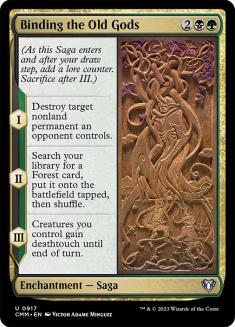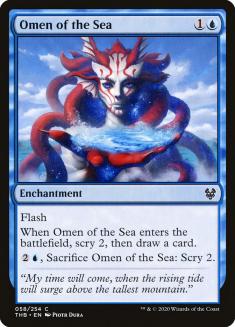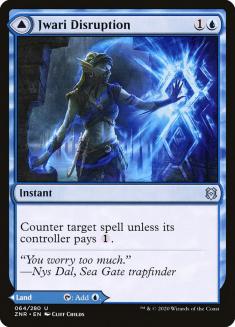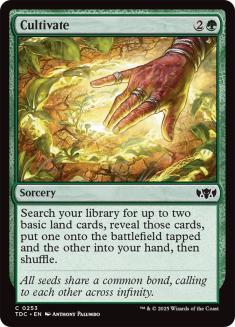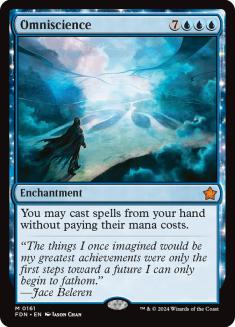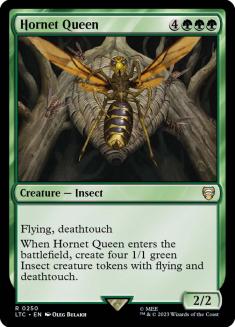CEDitor’s Note: Sam’s article was written without the knowledge that Uro, Titan of Nature’s Wrath is set to be banned in Pioneer, Modern, and Historic soon. We apologize for any inconvenience that may cause in enjoying this article.
With a new brand of Sultai emerging (pun intended) as the deck to beat in Kaldheim Standard, it’s time for Historic Sultai to consider whether there’s a place for any of these Kaldheim tricks alongside Uro, Titan of Nature’s Wrath and Nissa, Who Shakes the World. This is a fairly new archetype, but I’ve tried it a bit, and I think there is.
The most important addition to Sultai is Binding the Old Gods. This can be incorporated into the Historic Sultai shell regardless of whether you want to fundamentally alter the deck. Playing with the card, it felt like Historic midrange decks really aren’t prepared for it. There are a lot of expensive planeswalkers running around and answering them with a ramp spell is huge.
Maybe the solution is to stop there: replace some interactive spells with a slightly bigger interactive spell and call it a day. Or maybe you want to take advantage of the fact that these decks don’t play a lot of counterspells and try to go over the top.
Emergent Ultimatum is about as over-the-top as it gets, but it doesn’t really work in a 60-card deck because you need enough space for Emergent Ultimatum and several expensive cards you want to search for, and that’s just too much at the top of your curve in 60 cards. But with 80 cards, you can handle it.
Yorion taught us a lot about how bigger decks work, and I’d say that it illustrated lessons I’d argued for in the past, like how you can have a stronger mana base if you have room for a few extra basic lands in your deck without sacrificing the best duals available. If we want to play Emergent Ultimatum, we really want to take advantage of the benefits we get from having a larger library. As it happens, Yorion is such a benefit, so we’ll use the companion, but this is very much a deck that happens to have Yorion rather than a deck built around Yorion.
Emergent Ultimatum isn’t new. We could have been doing this at any point, so why would I think it’s correct to play it in Historic now? While Emergent Ultimatum isn’t new, its strength depends on the strength of the cards you can find with it, and Valki, God of Lies; Vorinclex, Monstrous Raider; and Alrund’s Epiphany are all new and offer vastly superior options to what was available even in Historic before.
So how do we merge the current Standard and Historic decks into the best of both worlds?
Creatures (9)
Planeswalkers (4)
Lands (35)
Spells (32)

I didn’t want to lose any of the essential cards that give the Historic deck its power — Thoughtseize; Growth Spiral; Uro, Titan of Nature’s Wrath; and Nissa, Who Shakes the World feel like the essential core of that deck.
I also wanted to keep all the pieces from the Standard Sultai Ramp deck that make it work — Cultivate; Binding the Old Gods; Emergent Ultimatum; Vorinclex, Monstrous Raider; Kiora Bests the Sea God; Valki, God of Lies; and Alrund’s Epiphany.
As it happens, these two cores line up exceptionally well. The Historic cards cost one, two, three, and five mana, while the Standard cards cost three, four, and seven mana. Cultivate provides desirable redundancy with Uro when you’re trying to cast expensive spells. Binding the Old Gods slots in before you can cast Nissa, and the Forest it finds pairs perfectly with Nissa’s gameplan. The ramp core from the Historic deck brings you quickly to the end-game from the Standard deck that can transform the slugfests we’ve seen in Sultai mirrors into a game that just ends when you resolve your seven-mana spell.
One question I had was whether Omen of the Sea is an essential part of the Standard package. Yorion is much stronger if you play Omen of the Sea, but it also asks you to invest mana in a card that doesn’t play well with Uro, Titan of Nature’s Wrath. Ultimately, I decided that I should embrace the idea that Yorion is an afterthought in this deck. Most of the time, you’ll have better things to do, such that most games will end without even putting Yorion in your hand, so it’s not worth investing mana to make that play better.
The Standard Sultai deck also uses a lot of DFCs. These are great in a deck with a high land count that risks flooding out, but Uro, Titan of Nature’s Wrath and Hydroid Krasis do a lot to mitigate that risk and DFCs are worse when you have Nissa, Who Shakes the World in your deck, since they’re not Forests, so I think it’s better to skip most of them in Historic.
I’ve opted against Explore because I think Cultivate is a better card if you can play enough basic lands to support it, especially since Growth Spiral and Uro offer enough extra opportunities to play lands that you won’t have a land to play too often, and Cultivate helps mitigate that. Also, the deck already has a lot more two-mana plays than three-mana plays. Cultivate is a privilege afforded to us as a result of playing a larger deck and it’s one we’re happy to take advantage of.
Putting It All Together
Once I combined the cores of the two decks, the remaining project was rounding the deck out. Between Uro, Nissa, and the Emergent Ultimatum package, the deck has more than enough threats, but I wanted a few copies of Hydroid Krasis anyway for the uncounterable element. Beyond that, the rest of the deck was just tuning the removal. This is the hard part.
There are so many viable interactive spells with different advantages and disadvantages. This is an awesome development in Magic design that makes building a deck like this really hard.
I didn’t end up finding room for any counterspells or sweepers in the maindeck. Is that right? I have no idea. I know the deck has a ton of power and ability to go over the top of things and I didn’t have a lot of space, so I opted for the cheapest cards I could count on to buy time, which meant spot removal, but that certainly leaves some possible holes.
- 2 Fatal Push
- 2 Eliminate
- 2 Heartless Act
- 1 Soul Shatter
This is a sparse package but it’s supported by four copies of Binding the Old Gods. I didn’t include Bloodchief’s Thirst because the kicked version is basically a bad Binding the Old Gods and the cheap version is a bad Fatal Push.
Fatal Push is there for speed; Heartless Act offers broad coverage; Eliminate covers Narset, Parter of Veils and Scavenging Ooze while also answering most threats that come down before I can cast Binding the Old Gods; and Soul Shatter is my expensive spell of choice instead of Mythos of Nethroi or Maelstrom Pulse because it answers Dream Trawler or other things I can’t target, while the other three-mana options are more redundant with Binding the Old Gods. In other words, all my other removal choices were made to round out the utility that’s already offered by Binding the Old Gods.
The primary ways in which I think this removal package is lacking are its ability to exile and to answer a wide battlefield. To account for this, I’ve opted for three Extinction Events in the sideboard, but that could be insufficient. It’s possible that the deck needs to play an Extinction Event over a Binding the Old Gods, but I wanted to lean into Binding since I think it’s perfect for this deck, and so far, it’s performed well for me.
This deck has a lower percentage of lands than the typical Standard or Historic versions of Sultai, but Historic lists don’t typically have Cultivate and Binding the Old Gods, which offer additional mana, and the Standard lists don’t have Growth Spiral, Uro, and Nissa. It’ll take some testing to figure out if this balance is exactly right, but I think it makes sense.
It’s worth asking whether there are any better cards we can find with Emergent Ultimatum in Historic. The best I could find were Hornet Queen and Omniscience. I think the packages that exist win the game a vast majority of the time and Omniscience is only rarely an upgrade to search for and much worse than any of the other cards to draw. Hornet Queen is probably better than Kiora Bests the Sea God by itself, but I think Kiora Bests the Sea God is better with Vorinclex or Alrund’s Epiphany than Hornet Queen, so I’d guess Kiora Bests the Sea God is a little better, but these are close enough that it might be better to go the other way.
Sticking with only one Vorinclex and only two Hydroid Krasis feels a little light, but given how strong Uro and Nissa are, the Emergent Ultimatum package already feels a little like overkill, so I wanted to keep it as lean as possible to have as much room as I could for lands, removal, and ramp. Depending on the metagame, I could see cutting Hydroid Krasis altogether (or, more likely, swapping it to the sideboard).
As for the lands, I wanted Fabled Passage to help with Uro, and between Fabled Passage and Cultivate, I wanted plenty of basic lands to find. I believe Castle Locthwain is the best utility land but I wanted to minimize basic Swamps since it doesn’t play well with Uro and I wanted every land that taps for green to be a Forest to maximize Nissa, Who Shakes the World.
Since almost all of my lands have basic land types, Drowned Catacomb is a good fit, since Watery Grave wouldn’t be a Forest anyway, but I also wanted Watery Grave in case I want to cast Thoughtseize on Turn 1 and I thought it would be good to have a few Fetid Pools to help with Uro. I avoided Pathways because I don’t want to play a Pathway on black because of Uro or green because of Nissa.
In the sideboard, I definitely wanted Narset and Shark Typhoon for the mirror. I’m not really looking for extra threats like The Scarab God or Elder Gargaroth because this deck is already so threat-heavy, so I wanted more cheap removal for aggressive decks and some kind of sweeper and exile effect.
Maxing out on Fatal Push seemed like the best approach against any hypothetical cheap creatures, and Extinction Event covers some of my need for a sweeper and some of my need for exiling. Cry of the Carnarium could also be used here, but it feels a little too narrow. I rounded out with a few versatile interactive cards, but you could really substitute whatever two-mana interactive spells you like.
I believe the the advantage this deck gains in finishing power in midrange mirrors is far more significant than any costs in might incur from a slightly higher curve or inconsistency from its larger size. I suspect that the closing power is even helpful in other hard matchups, like against Goblins, where ending the game before running out of answers to Muxus, Goblin Grandee is necessary.
From what I’ve seen so far in Historic, there are enough Uro decks that I think it’s correct to include the Emergent Ultimatum package. This deck maintains enough of the strength of traditional Sultai at grinding and interacting, while Emergent Ultimatum offers a real ramp payoff that’s on an entirely different level from just casting a big Hydroid Krasis.


